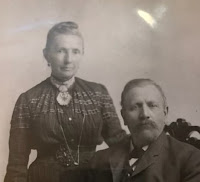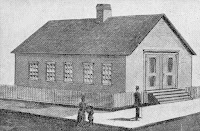Note: This sermon was delivered on the occasion of the 175th anniversary of First St. Paul’s Lutheran Church in Chicago, Illinois on All Saints Sunday (November 7, 2021). The Preacher was Rev. Peter K. Lange, First Vice-President of the Lutheran Church Missouri Synod.
✠ ✠ ✠
Dear saints, gathered for this feast today at First St. Paul’s Evangelical Lutheran Church—Chicago, Grace and peace to you from God our Father and the Lord Jesus Christ!
God’s Word for our consideration on this All Saints Sunday, and 175th anniversary celebration of this congregation, are the Old Testament and Epistle readings we’ve heard.
We’ll get to those in a few minutes, but first I’d like to tell you about a man named Frederick and his family.
It was May 5, 1891 and it was his wedding day! He was being united in holy marriage to Nellie, whose father had come from Germany and whose mother was born in Buffalo Grove. Their wedding was at First St. Paul’s Lutheran Church (at Franklin and Superior, in Chicago), and their pastor was Rev. Henry Wunder who had been pastoring the congregation for 40 years by that time. When Pastor Wunder’s ministry ended 22 years later, the church records would show that he married 5,062 couples(!), baptized 17,350 of their children, and buried 6,361 dear saints of this congregation.
 |
| Frederick and Nellie |
The church building itself (on the corner of Franklin and Superior) was quite new, because the original building at that location had been destroyed 20 years earlier by the Great Chicago Fire. Franklin and Superior was actually the second location for First St. Paul’s, the previous being on Grand Avenue, between Wells and Franklin. And, before that even, the founding members of this congregation worshipped with other German Protestant immigrants at the corner of Ohio and LaSalle, which is where the founding meeting for the Lutheran Church—Missouri Synod was held 175 years ago this coming April.
As Frederick stood before the altar on that spring day, a 23-year-old man, he really didn’t remember much about that Great Fire 20 years earlier, that killed 300 people and destroyed 17 ½ thousand homes, including many from the congregation, and including his own family’s home just southeast of Goose Island. Frederick’s mother Anna was great with child that night of the fire and yet had to flee west with her husband John to escape the flames that were moving north and east. They found a safe barn where Anna gave birth to a daughter, Katie, just eight days after the fire.
 |
| Anna and John |
Frederick’s father John, a milk distributor, had come to Chicago from northern Germany (near Rostock) 14 years before the fire, just nine years after that fateful congregational meeting which Pastor Selle and four other members left to form First St. Paul’s—a congregation that pledged faithfulness to the Scriptures as confessed in the Lutheran Book of Concord of 1580. John was 17 when he came to the U.S. along with his mother Mary and several siblings. All-in-all Frederick’s father John would be affiliated with First St. Paul’s for 62 years before he was buried from this congregation by Pastor Kowert, in 1919. By that time (1919) the congregation had moved to its third location—this present site—moving into a former Jewish synagogue in 1910… a building that served the congregation until this present one was dedicated in 1969.

Little did Frederick know, on his joyous wedding day, that he and his beloved bride would be blessed with seven sons, the fifth of whom was Wilburn who was baptized on September 2, 1906 by Pastor Wunder. As a grown man Wilburn would be Superintendent of the Sunday School here at First St. Paul’s, a Sunday School that in the year of Wilburn’s confirmation by Pastor Kowert had 300 students!
In 1934, Frederick, this proud father of seven sons, would receive his crown of eternal life and be buried from First St. Paul’s by Pastor Kowert. His dear wife Nellie would survive him by three years and also be buried from First St. Paul’s. (The cemetery for all these generations of Frederick’s family was the Rosehill Cemetery, as the family had moved north about the time of World War I.)
 |
| Wilburn's Confirmation Day |
But before Frederick would fall asleep in Christ, he would witness the marriage of his fourth son Wilburn to Marie Borchardt of Bethany Lutheran Church here in Chicago. Wilburn and Marie were very active at First St. Paul’s… with Wilburn serving, not only as Sunday School Superintendent, but also as an elder and usher. Marie sang in the church choir with Professor Beck, later recounting a Christmas party at his home in River Forest. The Lord blessed Wilburn and Marie with three children, the second of whom is my mother.
Finally, in October 1945, Wilburn moved his family to Algonquin, IL taking with him the fifth generation of Lettos to be associated with First St. Paul’s.
The congregation continued on, ministering to new mission fields and new ethnic groups whom the Lord brought to its changing neighborhood. And that brings us to today, celebrating 175 years of life together and ministry for the people of First. St. Paul’s Evangelical Lutheran Church in Chicago.
My family story, as it intertwines with First St. Paul’s, isn’t unique. There are many such stories for First St. Paul’s and for every congregation of saints gathered around pulpit and altar. Each of your families has a similar story, even if not fully chronicled. And future generations will include us in their stories.
 |
| First St. Paul's original building |
I tell this story because it provides a unique window into the 175-year story of First St. Paul’s, but also because it’s the story of saints… everyday saints… saints among the untold number for whom we give thanks on this All Saints Sunday… men and women, boys and girls who are saints not because they were more sinless than you or me… not because they were “family,” not because they were part of a nostalgic, bygone era… but because they were made saints by the Holy One himself who loved them, as His heavenly bride, “and gave Himself up for her, that he might sanctify her, having cleansed her by the washing of water with the word, so that he might present the church to himself in splendor, without spot or wrinkle or any such thing, that she might be holy and without blemish” (Ephesians 5).
The theme for this 175th anniversary celebration is, “HE WHO PROMISED IS FAITHFUL” (from Hebrews 10:23). And the Old Testament reading for this All Saints Sunday records one of those promises of God, through His prophet Isaiah, who looked ahead during Israel’s time of exile from Mount Zion in Jerusalem, and promised those suffering saints:
On this mountain the LORD of hosts will make for all peoples
a feast of rich food, a feast of well-aged wine,
of rich food full of marrow, of aged wine well refined.
7 And he will swallow up on this mountain
the covering that is cast over all peoples,
the veil that is spread over all nations.
8 He will swallow up death forever;
and the Lord GOD will wipe away tears from all faces,
and the reproach of his people he will take away from all the earth,
for the LORD has spoken.
9 It will be said on that day,
“Behold, this is our God; we have waited for him, that he might save us.
This is the LORD; we have waited for him;
let us be glad and rejoice in his salvation.”
One of the interesting (and sometimes frustrating) things about Old Testament prophecies is that it’s hard to pin down a single place or time that the prophet is talking about. What “mountain” is Isaiah referring to here? When will all these wonderful things take place? And what is “that day” of which the prophet speaks?
On All Saints Sunday our thoughts are appropriately raised heavenward as we think of our loved ones who have died in the faith and are now with the Lord, awaiting the resurrection of the body, and the full number of the elect to join them around the heavenly throne. We think of them and we look forward to joining them and to the fulfillment of God’s promise that we heard in today’s Epistle reading, from Revelation chapter 21, that at the Lord’s final coming He “will wipe away every tear from their eyes, and death shall be no more, neither shall there be mourning, nor crying, nor pain anymore, for the former things have passed away.” God has promised that for those who die trusting in Jesus as their Savior from sin. And HE WHO PROMISED IS FAITHFUL!
 |
| “This Holy Mountain” as it appears today. |
So “this mountain” of which Isaiah speaks, and “that day” is ultimately heaven—the new Jerusalem of Revelation 21. But it’s also, in a preliminary sort of way, the time of Christ, the New Testament Church in which the Lord already gives His eternal gifts—“spreads a feast of rich food” as it were—because of His suffering, death, and resurrection, even though those gifts are not yet fully revealed and are still given, in this life, against the backdrop of the consequences of sin.
And so, those who have died in the faith (including our loves ones), knew well the tears of this life. Think of the tears shed at the massive loss of property in the Chicago fire, or the loss of livelihood (and often self-esteem) resulting from the Great Depression. Think of the tears that attended the thousands of funerals in this congregation alone! And yet, by His death and resurrection, the Lord has swallowed up death forever! He destroyed its permanent grip by paying with His own life the price of death for sin. And so, because of Jesus Christ and His atoning work, the promises that will be fully revealed in heaven are revealed to the eyes of faith already now, so that even today—in the midst of hardship and tears—the Lord God wipes away tears from our faces (by His Gospel promises) and gives us a faith-filled reason to say, “Let us be glad and rejoice in His salvation!”
What is more, “on this mountain”… that is, in His Holy Christian Church, in congregations such as First St. Paul’s, the Lord of hosts makes “for all peoples a feast of rich food and a feast of well-aged wine.” It’s a feast for “everyday saints,” like you, whose stories will be recounted by future generations. Saints who are saints, not because of how holy and sinless you are, but because your Heavenly Bridegroom has made you saints by the washing of water with the Word in Holy Baptism.

In this place the Lord of hosts already today prepares a feast of rich food. It’s a feast of the preaching of His precious Gospel, the assurance that God forgives you all your sins because of His Son Jesus Christ who gave His life into death on a cross in payment for the sins of the whole world. And it’s a feast of this very Bread of Life Himself who gives His body and blood to us as a foretaste of the eternal Feast of Victory that awaits us in heaven. All Saints Day is about the saints in heaven, to be sure, but it’s also about you, His saints on earth today, who are blessed in your mourning, and poverty of spirit, and every other seemingly lowly condition, because you are Jesus’ own by faith, and you have His promises, and HE WHO PROMISED IS FAITHFUL!
And remember that this feast that the Lord spreads already today in His Holy Christian Church—this feast that will reach its fulness in heaven—is a feast that’s for all people… people from “every nation, from all tribes and peoples and languages” (Rev. 7:9). And so, even as you have been blessed with a seat at this feast, the Lord continues to use you—the stewards His gifts and members of First St. Paul’s in its 176th year—to make provision so that His feast can continue to be shared with all whom He invites to this place.
What a wonderful heritage God has given this congregation for 175 years! What an honor you have to be the host congregation for the formational meeting of the Lutheran Church—Missouri Synod! But, even better, what a precious treasure you (like those before you) have in the promises of God… promises like Isaiah 25 and Revelation 21 that are all about Jesus. And
HE WHO PROMISED IS FAITHFUL!
In the name of the Father, and of the Son, and of the Holy Spirit. Amen!
✠ ✠ ✠























